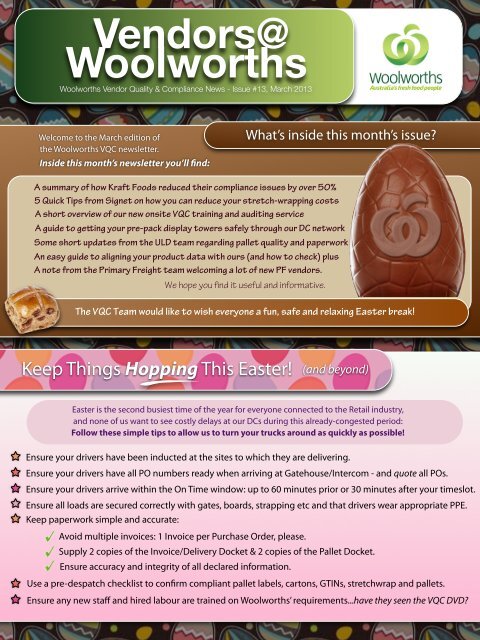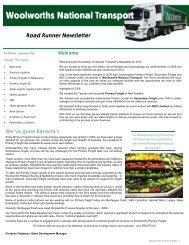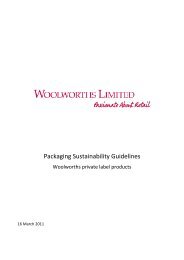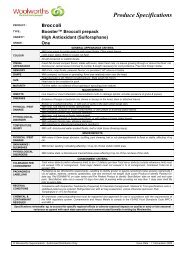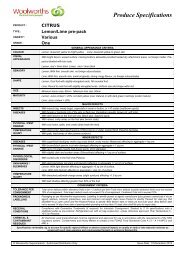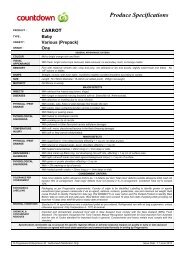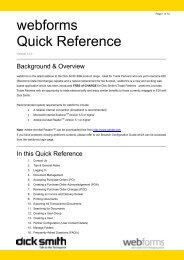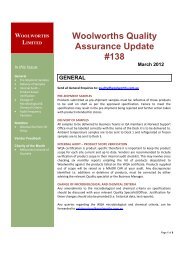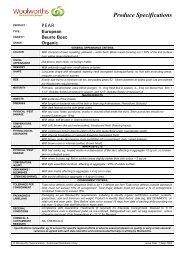Woolworths wowlink
Woolworths wowlink
Woolworths wowlink
Create successful ePaper yourself
Turn your PDF publications into a flip-book with our unique Google optimized e-Paper software.
Vendors@<strong>Woolworths</strong><strong>Woolworths</strong> Vendor Quality & Compliance News - Issue #13, March 2013Welcome to the March edition ofthe <strong>Woolworths</strong> VQC newsletter.Inside this month’s newsletter you’ll find:What’s inside this month’s issue?A summary of how Kraft Foods reduced their compliance issues by over 50%5 Quick Tips from Signet on how you can reduce your stretch-wrapping costsA short overview of our new onsite VQC training and auditing serviceA guide to geing your pre-pack display towers safely through our DC networkSome short updates from the ULD team regarding pallet quality and paperworkAn easy guide to aligning your product data with ours (and how to check) plusA note from the Primary Freight team welcoming a lot of new PF vendors.We hope you find it useful and informative.The VQC Team would like to wish everyone a fun, safe and relaxing.Easter break!Keep Things Hopping This Easter!.(and beyond)Ensure your drivers have been inducted at the . sites to which they are delivering.Ensure your drivers have all PO numbers ready when arriving at Gatehouse/Intercom - and quote all POs.Ensure your drivers arrive within the On Time window: up to 60 minutes prior or 30 minutes after your timeslot.Ensure all loads are secured correctly with gates, boards, strapping etc and that drivers wear appropriate PPE.Keep paperwork simple and accurate:.Easter is the second busiest time of the year for everyone connected to the Retail industry,and none of us want to see costly delays at our DCs during this already-congested period:Follow these simple tips to allow us to turn your trucks around as quickly as possible!Avoid multiple invoices: 1 Invoice per Purchase Order, please.Supply 2 copies of the Invoice/Delivery Docket & 2 copies of the Pallet Docket.Ensure accuracy and integrity of all declared information.Use a pre-despatch checklist to confirm compliant pallet labels, cartons, GTINs, stretchwrap and pallets.Ensure any new staff and hired labour are trained on <strong>Woolworths</strong>’ requirements...have they seen the VQC DVD?
Keep up the GREAT work!We spend a lot of time working with vendors to help them raise their delivery standards andreduce any negative impacts on our DC network. So, when we see suppliers making a strongcommitment to resolving their issues, putting robust corrective actions in place, and beginning toshow real progress in their compliance figures, we’re always keen to recognise that great work.As we’ve done over the past few newsletters, we’ll continue to dedicate space ineach newsletter for this recognition, and this month we’re happy to highlightsome fantastic work (and impressive results) from Kraft Foods...What’s this vendor achieved?Kraft Foods was put onto our Intensive Care Program (ICP)twice in 2012 - in both cases because the number ofpallet-related complaints we were receiving from our DCteams (around pallet quality, pallet labelling and stretchwrappingissues) were in excess of our expectations,After initially addressing the problem with some additionalDC checks and audits of outbound loads, the Supply Chainteam - led by Shaun Onley and Michael Begg - soon foundthat these short-term fixes quickly lost their impact, andthat the early improvements were not sustained.Above: Kraft’s total VQC non-conformances are now half what theywere 5 months ago - and this has proven to be sustained & consistent.Kraft’s (Cadbury) plantin Claremont, TasmaniaThe team decided to take adifferent, more-rigorousapproach next: thorough rootcause analysis was conducted,a Continuous Improvementteam was directed at theproblems, and a Lean Six Sigmawas implemented to fix theissues at their source.We’ve seen tremendous,sustained improvementfrom Kraft and now - wherewe were sometimesreceiving 40+ pallet-relatedKraft complaints each weekfrom our DC’s - we’ll oftenreceive fewer than 10.How did/do they manage that?Kraft Foods’ approach was multi-faceted and included:✓ Conduct audits on multiple Kraft deliveries being unloaded at WW sites,.to understand nature of issues and provide feedback to Kraft DCs✓ Identify (from data) biggest drivers in terms of both issue type and source✓.Implement dedicated a resource from our Continuous ProcessImprovement team: work with plants on reducing non-conformance issues✓ Implement CI process at Sites covering issues within Kraft’s direct control:★ Implement printer maintenance program to address print quality issues★ Implement new pallet wrapping standards at Manufacturing & Distributionsites (including some capital equipment upgrades)★ visit sites that feature most prominently in the data - meet with Back OfFactory team, review SOPs and validate against expected standards✓ Audit pallet deliveries from CHEP into main manufacturing site; identifyissues and introduce new SOPs for pallet quality and pallet inspection✓ Support with short-term resource at Victorian DC for final quality checkAs the above pareto chart shows, 50% of all Kraft issues related toCHEP Pallet Quality - easily their #1 issue ahead of Pallet Label andStretchwrap issues - which led Kraft to implement new SOPs andchecks around inbound pallet quality, and engage a 3rd party to review.Kraft also tracks every complaint to it’s origin point, to quantify thescope of problems and allow the proper focus and corrective actions.. Kraft teams continue to meet weekly to review each site’s performance..Well done, Kraft Australia team, and keep up the great work!Shaun Onley, Kraft’sCustomer Supply ChainDevelopment Manager ANZ
VQC Onsite Training & Auditing ServiceSince September 2009, the Vendor Quality & Compliance Team has been conducting regularly-scheduledVendor . Training Sessions at our sites in Melbourne, Sydney & Brisbane. These free, half-day sessions giveparticipants an excellent opportunity to understand <strong>Woolworths</strong>’ requirements; Vendors who attend thesesessions tell us that they find them highly informative and a huge advantage in understanding whycompliance is so important and learning exactly what they can do to improve their own performance.Beginning in 2013, the VQC Team will only run these sessions three times over the course of the year; seatsare very limited and the sessions can only be offered in those three Eastern, mainland states at this time.We understand that, as people move in and out of your business, it can be difficult to keep re-educating andto find the time to get everyone to a training session...so the VQC Team are now offering to come to you.What Does The Service Offer?Tailored training session(s) for your company, covering:SSCC Pallet Labelling Carton GTINsPallet WrappingCarton QualityPallet StabilityCarton LabellingPallet QualityShelf-Ready PackagingWOWlink Navigation D.O.T., I.B.S.L., A.D.S.L.WOWlink Reporting G.P.O.A., Case Fill etcReview/discussion of company-specific VQC issues...and a Full Site Audit (or Audits) with Full Audit ReportIf you can’t make it to our sessions, a member ofthe <strong>Woolworths</strong> VQC team can travel to your site(or multiple sites) to conduct training and auditing.Vendors utilising this new service - including Heinz,Tey’s, Tassal & Pernod Ricard Australia - have foundit invaluable; it allows sole focus on their business,detailed evaluation of their despatch operations,and means that whole teams can benefit fromtraining without the time and expense of travel.If you are interested in this one-on-one Service,contact the <strong>Woolworths</strong> VQC team - 02 8885 3361 orvendorcapability@woolworths.com.au - for details.Why are vendors choosingPrimary Freight?Nestle, Unilever, Inghams, Sanitarium, Lion Nathan, Kraft and close to 800 other vendorsare using Primary Freight to deliver product into <strong>Woolworths</strong> distribution centres.The customer service and operations team ensure the highest level of service by managing the pick upand delivery of <strong>Woolworths</strong> orders, whilst ensuring chain of responsibility compliance is met.<strong>Woolworths</strong> Primary Freight has welcomed many new clients recently through its commitment todelivering product on the right day, in the correct quantity and quality. Primary Freight nowdelivers almost 80,000 pallets per week into <strong>Woolworths</strong> distribution centres, with an inboundservice level (delivered on day) for Primary Freight vendors of 99.2%.Some of the <strong>Woolworths</strong> vendors to start using <strong>Woolworths</strong> Primary Freight recently areAustralian Bakels, Blue Lake Milling, Jalco, Pacific Food Industries, Super Pop, Dairy Brands,Cherry Isle, Mangrove Mountain, General Mills, Barfresh, Bella Pastry, R & R Smith, AroonaValley Springs, Borella Eggs, Valcorp, Fresco Gourmet, Citrus Direct, Gruma Oceania, SoulFresh, Marine Produce Marketing, Diaco Gattuso, Procal Dairies and J Allen Produce.For more information on Primary Freight please contact Karen Turner on 0437 349 730 or (02) 88856505.
Stretchwrapping 101with Adrian MoranContinuing from his piece in our last newsletter, we’ve again askedAdrian Moran, Corporate Business Manager with Signet, to providesome basic tips and guidelines regarding stretch wrapping.Outlined below is Adrian’s“Stretch wrapping machinery hints and tips”,with a particular focus on minimising the costs to your business.Getting the most from your stretch wrapping machinery is a great way to reduce costs and minimise your waste. Below are5 simple tips that will allow you to cut your film consumption, without impacting on your load containment requirements.12345The Right Film:Check that the correct film is being used for the machine’s stretching capabilities and that the machine can pre stretchthe film. A simple way to reduce film usage could be through the use of performance stretch films. These films aremanufactured with lower gauges, yet offer similar performance characteristics to that of heavier gauge films.Alternatively, conventional cast films usually provide a lower cost per wrapped pallet when compared to blown films.Cast stretch film can be identified by the high clarity & low unwinding noise when compared to blown stretch film.Know Your Machine:There is a large range of stretch film machines available with the settings and capabilities varying considerably.The three types of stretching mechanisms you may encounter are:A. Friction brake machines are designed to apply resistance directly to the roll, in turn stretching thefilm. This is adjusted manually via the handle/brake systemB. Electromagnetic brake machine provides enhanced stretch through a clutch system that appliesforce to the main roller creating a small amount of stretch. The force applied can be adjusted on themain control panel.C. Power pre-stretch machines apply a nominated percentage of stretch to all films via the gearing ofthe machine. These gears set the rollers at two different speeds causing the film to stretch as itpasses through. This is the most effective stretching mechanism as it allows the film to be stretchedfurther to improve load retention and also reduce wrapping costs.Check Your Overlap:The perfect amount of overlap is a significant contributor to load containment, while too much overlap will increase filmwaste. Ensure that the overlap of the stretch film during the wrapping cycle is adequate by adjusting the carriage and/orturntable speed. This helps correct the amount of overlap applied during the wrapping cycle. Generally, an overlap of75mm is adequate but the weight, height & type of each load will need to be analysed to determine the necessary overlap.Check Your Machine Settings and Train Your Staff:Check the wrapping program setting on your machinery to ensure that there is an appropriate amount of film beingapplied and that the pallets are not being over-wrapped. Signet can help you achieve this by analysing the machinerysettings and film application with our Test Cube. The Test Cube examines the load holding, puncture resistance andcorner crush of the current film and machinery settings. It also provides a comparison against alternative films andsettings to assist with cost reduction, whilst maintaining suitable load containments. To further ensure your settings arealways correct, staff members who regularly use the machine should be trained in the full operation of the wrapper.Signet recommends having a standard operating procedure (SOP) for your machines.Maintain Your Machine:Machinery maintenance is one of core aspects of reducing costs and ensuring your load containment is optimal. Some ofthe signs associated with poor maintenance are dirty or misaligned rollers, reduced stretching capabilities, turntablemalfunctions and machinery breakdowns. All of these problems can increase costs, slow production, impact loadcontainment or result in changing to heavier more expensive gauge films. Preventative maintenance programs willenable the machinery to continue to perform efficiently and provide consistency in your pallet wrapping practises.Signet is always happy to assist any <strong>Woolworths</strong>’ vendor with the analysis their machinery and stretch film.If you would like to gain a better understanding of your current machinery and film performanceplease contact Adrian Moran on amoran@signet.net.au.
Service Levels & Stock SupplyAt <strong>Woolworths</strong>, satisfying the needs and expectations of our customers is our mostfundamental objective, and a critical part of that objective is ensuring that products arealways available to the customer when and where they need to purchase them.Our General Manager of Replenishment, Kath McLay, recently sent a letter to all tradepartners to reinforce this objective, convey what internal measures <strong>Woolworths</strong> hasimplemented to improve on-shelf availability, and to outline our expectations of suppliersregarding stock supply. As Kath pointed out, on-shelf availability is oneof the key drivers of customer confidence. ‘Out of stocks’ not only causefrustration, disappointment, inconvenience and an immediate lost sales opportunity -evidence shows a “very high chance” that a customer will choose to shop elsewhere for ALL of their purchases.<strong>Woolworths</strong> has an expectation that all vendors will supply product to a 98% service level, and the support ofvendors in this area is critical. Kath offered that the <strong>Woolworths</strong> Replenishment Team is “ready and willing towork even more closely with you than we do today in order to secure maximum levels of stock availability.”If you need any assistance to maintain or improve your company’s stock supplycapability, please make contact with the <strong>Woolworths</strong> Replenishment team.123Three notes from the ULD/Pallet Control TeamAttention: Transport Company & Vendor Equipment ControllersAll <strong>Woolworths</strong> Distribution Centres require for the transport company or vendor to provide theequipment transfer docket at time of Receiving the delivery. Upon delivery of goodsan“Original”Equipment Transfer Docket is to be supplied by the Transport Company / Vendor.If you require a signed copy of the transfer docket, you are to supply the original and a copy ofthe transfer document. Where a copy is not provided, the original will remain with <strong>Woolworths</strong>.Pallet Transfers: Did you know?When transferring pallets, <strong>Woolworths</strong> has standard delay days across their Network as;AMBIENT: 30 days from Receipt DateCHILLER/FROZEN: 15 days from Receipt DatePRODUCE: 7 days from Receipt DateFor CHEP:<strong>Woolworths</strong> has a global equipment days offset (EDO) applied to our accounts to calculate the delay days. CHEP calculatesthe EDO from the Shipment/Movement Date. I.e. the scheduled Booking Date into the <strong>Woolworths</strong> Distribution Centre. Whenpallets are administered on the CHEP transfer, the Effective date is irrelevant and not considered.For Loscam:The Date is to reflect the date of receipt into the <strong>Woolworths</strong> Distribution Centre and the Effective Date is to be administeredas either; 30 or 15 or 7 days post the Date.20% of CHEP transactions require correction due to the transaction date being processed incorrectly.Correcting transactions takes a considerable amount of time for both <strong>Woolworths</strong> and the Supplier, and extends toconsiderable amount of time for the Sender with affirming the correction(s) and reasoning for this.Some vendors/carriers perceive that <strong>Woolworths</strong> are 'adding days' to their CHEP transfer. We don’t add days, we arecorrecting the transfer. The CHEP correction is administered against the Shipment/Movement Date which is adjusted toreflect date of receipt. The Loscam correction is administered against the Effective DateTo avoid rejection or correction of your transfers please ensure:CHEP: the Movement/Shipment date & Effective date is the receipt date into <strong>Woolworths</strong> Dist. Ctr.LOSCAM: that the Movement/Shipment date is the receipt date into <strong>Woolworths</strong> Dist. Ctr., and the Effective date is theamount of delay days from the receipt date. The primary reference on the transfer must be the <strong>Woolworths</strong> Purchase Order.VQC Non ConformanceQuestions? Need forms?Need to contact the team?Belinda Field,National ULD Manager(02) 8885 4144BField@woolworths.com.auTeresa Azzopardi,ULD Specialist(02) 8885 3959TeAzzopardi@woolworths.com.auWe appreciate your co-operation in continuously looking for ways to improve supply chain performance. One initiative we haveintroduced is to provide our hire equipment suppliers, CHEP and Loscam, with the non-conformance pallet issue details set outbelow. As a result, you may be contacted by your pallet supplier offering assistance in our joint endeavours to improve palletquality and pallet transaction management. If you have any queries regarding the program please do not hesitate to contact us.ORnationaluld@woolworths.com.au
Conflicting Transport LabelsMany vendors, 3PL’s and transport companies choose to track their pallets with a separate transport label,in addition to the standard SSCC pallet label that <strong>Woolworths</strong> require. While this in itself is not an issue,it immediately becomes an issue if vendors/3PLs use a label that contains a conflicting SSCC number.Our automated pallet Infeed systems scan the full face of both fork-entry sides of a pallet, looking for an SSCCbarcode (the 18-digit number beginning with a “00” Application Identifier) that uniquely identifies this pallet.If a second, conflicting SSCC barcode is picked up by the scanner, this will cause the pallet to be rejected.Rejected pallets then need to be collected from a reject lane, manually reworked and then sent backthrough the automated system to be made available for stores - adding costs and delays to the process.There is, however, a simple fix for this issue!If separate transport labels must be used, either:apply them to the non-fork entry side of the pallet ORapply them vertically on the forklift entry sides of the pallet.In either case, our fixed-head Infeed scanners won’t identify the conflicting SSCC barcode,but the label will still be available for your or your 3PL’s internal use with a hand scanner.Incorrect – Automated System will read both theTransport Label AND standard SSCC Pallet LabelCorrect – Automated System willONLY read the standard SSCC Pallet LabelQuestions? Comments? Feedback?This newsletter exists entirely for your benefit; as a training/education resource and as a way forus to keep you updated with any relevant news or changes. We hope it’s of value to you.If you have a topic that you’d like to see covered in a future newsletter, have questions aboutanything we’ve covered in this one, or just want to provide some feedback, feel free tocontact Matt Lowe on (03) 9263 2802 or mlowe@woolworths.com.auThanks for reading, and please consider posting the newsletter on your staff noticeboards and/or passing it on to other relevant people in your team/organisation as appropriate.
Displays & TowersKey ConsiderationsProduct Display Units can be an integral part of a successful product launch or salescampaign...but it’s important to ensure they’ll get through the DC network first!These aractive, eye-catching displays often need to be on show in <strong>Woolworths</strong> stores to coincidewith other media activities such as TV or print advertising, or to support specific social events likeEaster, Christmas, Spring Gardening or Back-To-School.In the past, we have had some Display Units rejected at DCs for safety reasons, resultingin the units not being available to stores to meet planned launch dates.Here are some key considerations that Trade Partners should be aware of to ensure thatthese non-standard units reach our stores in time to support a successful launch:Complete the <strong>Woolworths</strong> Risk Assessment (RA) FormMost Trade Partners understand that heavy items (those over16kg gross weight) require a RA form, but RA forms are alsorequired - regardless of weight - for bulky items. Any carton ortrade unit with dimensions exceeding 400mm X 500mm X850mm is classified as ‘bulky’.Please note: Completing the RA form does not automatically mean that yourDisplay Unit will be accepted. The RA form will be considered and either approvedor rejected by <strong>Woolworths</strong>’ National Safety, Health and Environment Manager.Use correct ‘Caution Lift’ symbologyPlease note that “D-Pallets” and other nonstandardpallets are notcurrently accepted within the<strong>Woolworths</strong> networkRecently, display units delivered to <strong>Woolworths</strong> DCs were labelledwith Caution Lift symbols that were not relevant to the actualgross weight of the unit, and the declared gross weight was notaccurate. These units were all rejected by the DC staff on safetygrounds.Consider how well the Display Unit will travel to storesPlease also note that themaximum pallet height for anydisplay unit is 1.8 metres(into <strong>Woolworths</strong> sites).Display units are sloed into <strong>Woolworths</strong> DCs like any otherproduct, and picking these units as part of an existing pick path canbe very challenging. Ensure that this is factored in whenconsidering/designing the dimensions and conveyability of yourdisplay unit.
Displays & TowersKey ConsiderationsComplete the <strong>Woolworths</strong> Risk Assessment (RA) FormThe Risk Assessment form can be found on Pages 87 & 88 of the <strong>Woolworths</strong>Packaging & Bar Code Specifications document. Completed forms must besubmied to the <strong>Woolworths</strong> Safety, Health & Environment team for review.Use correct ‘Caution Lift’ symbology<strong>Woolworths</strong> has a target weight for all TradeUnits of 12 kg, so it is strongly recommended tokeep the gross weight of Trade Units as low aspossible.<strong>Woolworths</strong> DC’s do not execute two person lifts.Our pickers work individually on specific pick paths.Consider how well the Display Unit will travel to storesThe pallets pictured (right) are typical of palletsbound for <strong>Woolworths</strong> stores. It can be extremelydifficult to incorporate bulky displays (inset) intoDC pick paths and on to store-bound pallets.NOTE: <strong>Woolworths</strong> National SH&E encourages theincorporation of lifting slots into the sides of display units,to aid safer manual handling.


